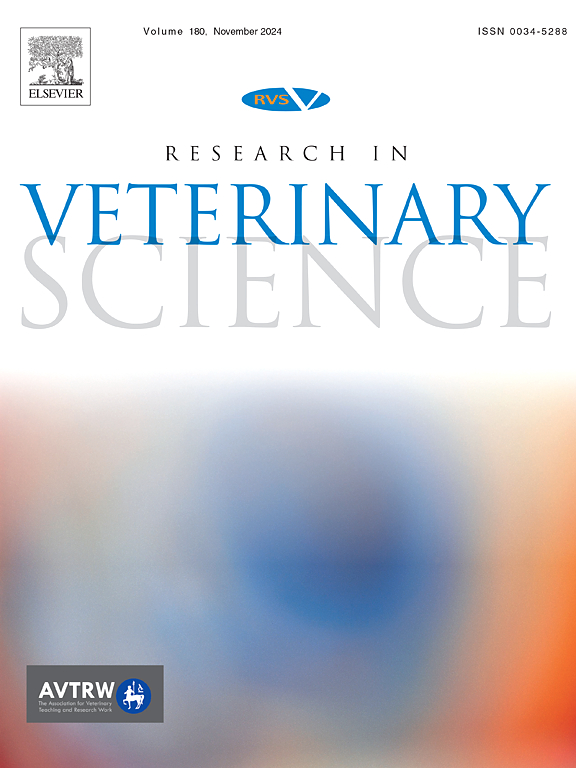野生鸟类作为环境抗菌药耐药性的潜在生物指标:初步调查。
IF 2.2
3区 农林科学
Q1 VETERINARY SCIENCES
引用次数: 0
摘要
抗菌药耐药性(AMR)是一个全球关注的问题,涉及人类、动物和环境健康。要解决这一现象,需要所有这些相互关联的因素共同参与,采取 "一体健康 "的方法。环境给调查带来了挑战,但野生动物不直接接触抗生素治疗,并与其栖息地相互作用,可以作为 AMR 污染的指标。具体来说,野生鸟类在传播 AMR 方面可以发挥重要作用,因为它们可以从野生动物水库中获取 AMR 细菌并通过环境传播。本研究旨在评估从野生鸟类体内分离出的共生细菌中的 AMR 感染率,以及它们作为环境 AMR 生物指标的作用。研究人员在艾米利亚-罗马涅(Emilia-Romagna)地区对不同种类的 73 种鸟类进行了口腔、泄殖腔和羽毛采样。样本在选择性培养基上进行培养,使用 MALDI-TOF 技术对菌落进行鉴定,并使用 Kirby-Bauer 方法对不同药物的抗菌敏感性进行评估。根据 AMR 百分比对鸟类数据进行了统计评估。总共分离出 117 株细菌,属于 23 个属和 46 个不同的细菌种类。在所有细菌分离物中,四环素(12.2%)和恩诺沙星(8.6%)的不敏感率最高,在革兰氏阳性分离物中,氧西林(46.8%)、克林霉素(29.3%)和利福平(20.8%)的不敏感率也最高。在统计分析中,来自农村/城市栖息地鸟类的革兰氏阳性分离物的 AMR 百分比较高(p = 0.01)。在革兰氏阳性菌中,从博洛尼亚省采样的鸟类分离物中发现较高的奥沙西林非敏感性百分比(p = 0.007),较高的恩诺沙星非敏感性百分比显示与农村/城市栖息地有关(p = 0.02),而较高的利福平非敏感性百分比与候鸟分离物有关(p = 0.031)。总之,这项初步研究表明,野生鸟类作为监测环境中 AMR 污染的生物指标具有潜在的作用。本文章由计算机程序翻译,如有差异,请以英文原文为准。
Wild birds as potential bioindicators of environmental antimicrobial resistance: A preliminary investigation
Antimicrobial resistance (AMR) is an issue of global concern that includes human, animal, and environmental health. To tackle this phenomenon, a One Health approach is required through the involvement of all these interconnected elements. The environment poses challenges for investigation, but wildlife animals, not directly exposed to antibiotic treatments and interacting with their habitats, can serve as indicators of AMR contamination. Specifically, wild birds could play a significant role in dissemination of AMR, as they can acquire AMR bacteria from wildlife reservoirs and disperse them through environments. This study aims to assess the prevalence of AMR in commensal bacteria isolated from wild birds and their role as bioindicators of environmental AMR. A total of 73 birds belonging to various species were sampled in the Emilia-Romagna region with buccal, cloacal and feather samplings. The samples were cultured on selective media, colonies were identified using MALDI-TOF technology and antimicrobial susceptibility to different drugs was assessed using the Kirby-Bauer method. The birds' data were statistically evaluated in relation to AMR percentages. In total, 117 bacterial strains were isolated, belonging to 23 genera and 46 different bacterial species. The highest non-susceptibility percentages were observed for tetracycline (12.2 %) and enrofloxacin (8.6 %) considering all bacterial isolates, as well as for oxacillin (46.8 %), clindamycin (29.3 %) and rifampicin (20.8 %), among Gram-positive isolates. In the statistical analysis, a higher AMR percentage was correlated with Gram-positive isolates from birds belonging to rural/urban habitat (p = 0.01). Among Gram-positives, a higher oxacillin non-susceptibility percentage was found to be associated with isolates from birds sampled in province of Bologna (p = 0.007), a higher enrofloxacin non-susceptibility percentage revealed an association with rural/urban habitat (p = 0.02), while a higher non-susceptibility percentage towards rifampicin resulted associated with isolates from migratory birds (p = 0.031). In conclusion, this preliminary study suggests a potential role of wild birds as bioindicators for monitoring AMR contamination in the environment.
求助全文
通过发布文献求助,成功后即可免费获取论文全文。
去求助
来源期刊

Research in veterinary science
农林科学-兽医学
CiteScore
4.40
自引率
4.20%
发文量
312
审稿时长
75 days
期刊介绍:
Research in Veterinary Science is an International multi-disciplinary journal publishing original articles, reviews and short communications of a high scientific and ethical standard in all aspects of veterinary and biomedical research.
The primary aim of the journal is to inform veterinary and biomedical scientists of significant advances in veterinary and related research through prompt publication and dissemination. Secondly, the journal aims to provide a general multi-disciplinary forum for discussion and debate of news and issues concerning veterinary science. Thirdly, to promote the dissemination of knowledge to a broader range of professions, globally.
High quality papers on all species of animals are considered, particularly those considered to be of high scientific importance and originality, and with interdisciplinary interest. The journal encourages papers providing results that have clear implications for understanding disease pathogenesis and for the development of control measures or treatments, as well as those dealing with a comparative biomedical approach, which represents a substantial improvement to animal and human health.
Studies without a robust scientific hypothesis or that are preliminary, or of weak originality, as well as negative results, are not appropriate for the journal. Furthermore, observational approaches, case studies or field reports lacking an advancement in general knowledge do not fall within the scope of the journal.
 求助内容:
求助内容: 应助结果提醒方式:
应助结果提醒方式:


